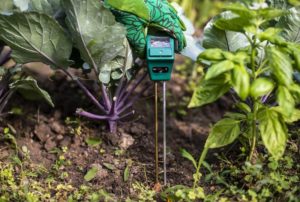Most gardeners know that your crops need different amounts of N-P-K, but what about important micro-nutrients? Trace minerals are something that most gardeners don’t think about.
Trace minerals are incredibly important to building great soil & healthier crops. I always add AZOMITE to my garden and I notice a yield & plant vigor difference.
Learn why AZOMITE is great for your garden soil.

What is AZOMITE?
AZOMITE is an acronym for the “A to Z of minerals including trace elements”. An estimated 30 million years ago, a volcanic eruption filled a nearby seabed. The unique combination of seawater, fed by rivers rich in minerals and rare earth elements present in the volcanic ash created the composition known as the AZOMITE mineral deposit.
AZOMITE is a natural product mined from an ancient mineral deposit in Utah (USA). Consisting of necessary trace elements, many of which are known to be vital for plant life. AZOMITE is used internationally as a feed additive and a soil re-mineralizer for plants. It’s available in over thirty countries throughout the world.
Azomite for Gardening
These AZOMITE trace minerals have been reported to:
- improve root systems.
- yields
- general plant vigor in a variety of field crops and garden vegetables
Available for a variety of applications, AZOMITE can be used to re-mineralize nutrient-depleted soils. It’s OMRI Listed for certified organic production.
Trace Minerals in Azomite
AZOMITE Ore Certificate of Typical Analysis
ICP and Spark Source Mass Spectrometry
ppm unless shown as %
| Aluminum 6.57% | Hafnium 0.62 | Ruthenium 0.01 |
| Antimony 0.16 | Holmium 0.60 | Samarium 4.98 |
| Arsenic 1.10 | Hydrogen 0.38% | Scandium 1.16 |
| Barium 0.14% | Indium 0.02 | Selenium 0.29 |
| Beryllium 0.51 | Iodine 2.20 | Silicon 30.68% |
| Bismuth 0.30 | Iron 1.16% | Silver 0.97 |
| Boron 29.00 | Lanthanum 21.05 | Sodium 1.31% |
| Bromine 6.60 | Lead 9.96 | Strontium 66.34 |
| Cadmium 0.07 | Lithium 18.23 | Sulfur 0.02 |
| Calcium 2.84% | Lutetium 0.30 | Tantalum 1.30 |
| Carbon 0.61% | Magnesium 0.59% | Tellurium 0.01 |
| Cerium 41.27 | Manganese 0.01% | Terbium 0.51 |
| Cesium 0.88 | Mercury 0.02 | Thallium 0.16 |
| Chlorine 0.22% | Molybdenum 0.23 | Thorium 7.51 |
| Chromium 3.82 | Neodymium 33.61 | Thulium 0.28 |
| Cobalt 1.54 | Nickel 1.66 | Tin 0.98 |
| Copper 2.85 | Niobium 0.18 | Titanium 0.14% |
| Dysprosium 2.95 | Nitrogen 0.15% | Tungsten 0.30 |
| Erbium 1.73 | Palladium 0.01 | Uranium 0.58 |
| Europium 1.03 | Phosphorus 0.02% | Vanadium 14.12 |
| Fluorine 900.00 | Potassium 4.19% | Ytterbium 1.86 |
| Gadolinium 3.60 | Praseodymium 10.31 | Yttrium 6.23 |
| Gallium 3.01 | Rhenium 0.01 | Zinc 12.71 |
| Germanium 0.09 | Rhodium 0.00 | Zirconium 24.68 |
| Gold <0.2 | Rubidium 24.41 | Loss on incineration 8.06% |
Guaranteed Minimum Analysis
Soluble Potassium
Calcium
Sodium
Magnesium
Soluble Magnesium








This is why IO use SeaCrop here in the PNW. 100% organic and produced in Tokeland Wa.
I have some Sakurajima radish plants started. These radishes grow 13lbs and up because of the volcanic ash soil in that part of Japan. Azomite is key. I was planning to gather some of Mt ST Helen’s ash and grow my radish plants in it to see if it increases the size of the bulbs . I’m curious. Any thoughts on my experiment?